Manchester, Bury, Rochdale and Oldham Steam Tramways
(from 1888, Bury, Rochdale and Oldham Steam Tramways)
History
The Manchester, Bury, Rochdale and Oldham Steam Tramways were the brainchild of an unscrupulous London businessman, Henry Osbourne O'Hagan; they required the consent of no less than 23 local authorities, with O'Hagan masterfully playing one against the other, to secure the approvals he needed. This included wining and dining entire councils at his expense, and various other practices that would today be viewed as completely unethical.
The tramway and its shareholders were hamstrung from Day 1, as the new company set up by O'Hagan to build and run the tramways — the Manchester, Bury, Rochdale and Oldham Steam Tramways Limited — was bound by onerous legal agreements, including paying exorbitant sums for building the tramway (to the promoters and contractors, Phillips & Co), as well as handsome dividends to the holders of the first £10,000 of shares (until the works were completed). The contractors were of course virtually unconstrained, having an almost free hand to do as they saw fit. Before construction commenced however, some more legal gymnastics took place, which saw Phillips and Co subsumed into a larger company, called the City of London Contract Corporation, a name which would come to haunt many a tramway company and its shareholders. Needless to say, O'Hagan was not only the principle partner in Phillips & Co, but also chairman of the CoLCC, the latter having several directors on the tramway company board, no doubt to ensure that any decisions taken were to the financial benefit of the CofLCC.
If things weren't bad enough, the MBR&OSTLtd was further handicapped by the Board of Trade, which insisted on the use of a narrower gauge in Bury and Rochdale. As a result, the system was split into three pieces: standard gauge southwards from Bury (to Whitefield, Prestwich and Kersal) and from Royton (to Oldham and Hathershaw), but everything else between these points (i.e, nearly all the lines in Bury, Rochdale and their environs) built to a gauge of 3ft 6ins. This inevitably resulted in significantly increased overheads and operational difficulties that were never really overcome.
The first rudimentary steam-hauled services commenced on the standard gauge line from Bury to Kersal Bar on the 12th March 1883, with a temporary horse-drawn service on the 3ft 6ins-gauge line from Bury to Limefield. As more lines were completed, it soon became clear that the engines were significantly underpowered, and the services suffered accordingly, as did the reputation of the company. The engines had been ordered by the contractor, without reference to the company, no doubt to save as much money as they could; despite new and more powerful engines being procured, the tramway still suffered from a severe shortage of stock, with consequent impacts on the services and takings. This in turn led to a lack of dividends and ultimately, a shareholder revolt, which precipitated the resignation of the chairman and managing director, both nominees of the CofLCC, local men taking over the reins.
It quickly became apparent that huge amounts of money had been spent (some seems simply to have disappeared), much of the planned work had not and never would be completed (this included a line to Rossendale, which the company would soon sell the rights to), and if that was not enough, there was significant debt too. Despite huge efforts by the new management, the creditors were circling, and in October 1887, a receiver was appointed to run the company. A new company was eventually formed in 1888 — the Bury, Rochdale and Oldham Steam Tramway Company Limited — in which the original shareholders received shares, though only about a third of their original holding. It may have been a reasonable price to pay to have been rid of O'Hagan and the CoLCC.
Although the new company quickly set about the task of getting the tramway onto an even keel, including abandoning some lines, it was to be a long process, and one involving many contretemps with the local authorities. Bury Corporation were particularly critical of the company's track and engines, eventually resorting, in 1894, to opposing the Board of Trade operating licence.
Whilst the company was in a much better state by the mid 1890s, and was even making noises about conversion to electric traction, by 1896, it was clear that several of the local authorities intended to build municipal electric tramways, and that the company's days were numbered.
Oldham took control of its lines (which it had always owned) in June 1902, and a year later, in June 1903, initial agreement was reached between the remaining various local authorities and the company on a sale, though crucially, not the valuation. The parties eventually signed a binding agreement on the 24th February 1904, so that work on electrification could progress, with a price being set by an independent referee. The outcome of arbitration, however, which was announced in July 1904, was much higher than any of the parties had expected, much to the company's delight, and the councils' consternation; the latter ended up having to take it on the chin, paying way over the odds for assets that were of no use whatsoever in the new electric tramway world, and which they then had to sell, at scrap prices, incurring substantial losses.
Meanwhile, the company continued to operate services whilst its lines were converted to electric traction. The last tram in Royton ran on the 30th May 1904, the last tram in Bury on the 10th July 1904, and the last tram in Rochdale, probably on the day before the company's assets were sold, i.e., the 12th October 1904.
At its maximum the tramway totalled 36.75 miles (33.25 miles of company-owned tracks and 3.5 miles leased from Oldham Corporation), which at the time, made it reputedly the largest steam tramway in the world. The system comprised lines: southwards from Bury to Broughton; northwestwards from Bury to Tottington; northwards from Bury to Limefield; eastwards from Bury through Heywood to Rochdale, with a branch southwards to Hopwood; northwestwards from Rochdale to Whitworth and Facit; northeastwards from Rochdale to Littleborough; and southwards from Rochdale through Royton and Oldham to Hathershaw, with a branch southwestwards to Werneth.
Although the steam tramway met and was connected to the tracks of the standard-gauge, horse-drawn, Manchester Carriage and Tramways Company at Broughton near Salford, as well as in Oldham, no through running ever took place.
Uniforms
The Manchester, Bury, Rochdale and Oldham Steam Tramways Ltd (MBR&OSTLtd; 1883-1884), as well as its later incarnations, the Manchester, Bury, Rochdale and Oldham Steam Tramways Company (MBR&OSTCo; 1884-1888) and the Bury, Rochdale and Oldham Steam Tramways Company (BR&OSTCo; 1883-1904), are extremely well represented photographically, so it’s possible to get a relatively good feel for the uniform policy of this early steam tramway.
Images taken during 1883 and 1888 (MBR&OSTLtd and MBR&OSTCo days) clearly show that drivers wore very similar attire to their railway counterparts, namely, heavy cotton trousers and jackets, predominantly light in colour. Headgear initially followed horse tramway practice — bowler hats — though these gradually gave way to grease top and soft-topped caps. No badges were worn, either on the uniforms or the caps. Conductors wore smart but informal attire, comprising jacket, shirt and tie, along with the fashionable headgear of the day, in this early period, the bowler hat.
Despite the available photographic evidence, which is admittedly relatively sparse for the first two years of operation, at least five examples of elaborate MBR&OSTLtd cap badges have survived (see below); these comprise the system title — 'M. B. R. &. O STEAM TRAMWAYS LTD' surrounded by a wreath, with an employee number cut out of the centre panel. Three of the examples are 'DRIVER' badges (with the grade in a scroll above) and two are 'CONDUCTOR' badges (with the grade in a scroll below). The precise form of the tramway's name is actually the earliest, i.e., before the assets were transferred to a new legal entity in July 1884, which differed solely by inclusion of the word 'Company'. All five badges are in extremely good condition, suggesting that they were either never issued, or that they were only worn for a very short period. It is tempting to speculate that the badges were ordered before the name change, and for whatever reason were not issued. This may explain why so many examples have survived for this very early period, presumably all together in a box somewhere through to modern times.
Following the takeover of 1888 by the newly formed BR&OSTCo, no change was made to drivers' attire, and they continued to wear railway-footplate-like clothing right up until the demise of the tramway in the early Edwardian era. Conductors on the other hand were now issued with kepi-style caps; these bore a large oblong cap badge — almost certainly metal — with a semi-circular protrusion in the middle at the top, somewhat reminiscent of American railroad and 'trolley' practice. No examples are known to have survived. Towards the end of the company's life, around the turn of the century, the caps appear to have been dispensed with, so conductors simply wore flat caps along with whatever informal attire they wished.
A single photograph has survived (not shown) that appears to show an inspector (taken in BR&OSTCo days). Based on this photograph, inspectors wore smart but informal jackets, waistcoats, shirts and ties, topped off with a tall kepi-style cap — presumably company issued; the latter appears to have been plain, i.e., without a badge, or at the very least a reflective (metallic) one.
Further reading
For a history of system, see: 'The Manchester Bury Rochdale and Oldham Steam Tramway' by W G S Hyde; The Transport Publishing Company (1979).
Images
Steam tram drivers and conductors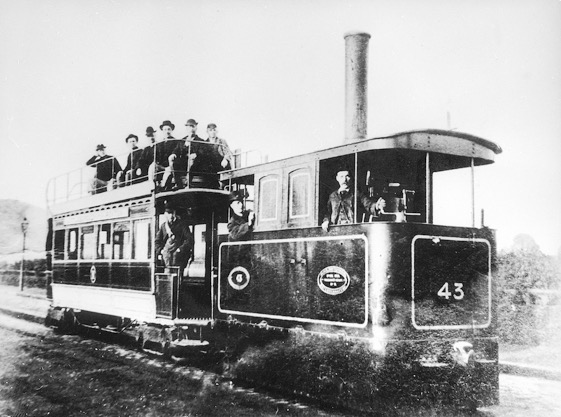
Narrow gauge Black Hawthorn Steam Tram No 43 (of 1884) posed for the camera with what is probably a brand-new Falcon trailer, dating the image to 1885, i.e., in MBR&OST days. Photo courtesy of David Gladwin, with thanks to Trevor Preece.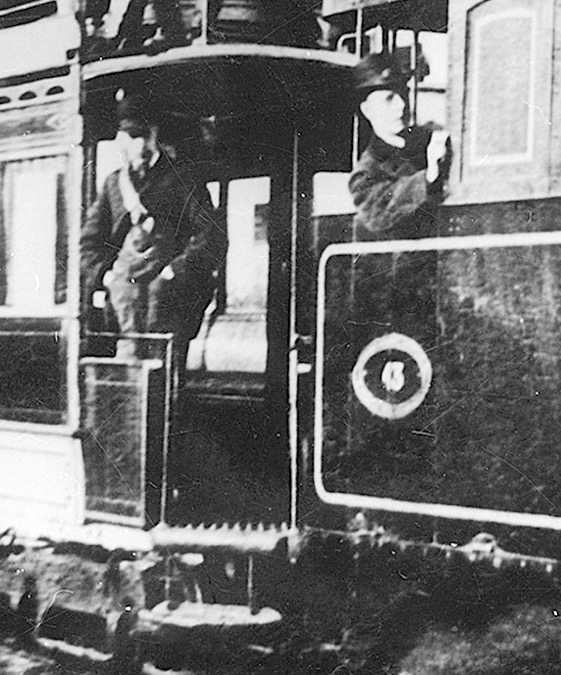
An enlargement of the above photograpg showing the conductor (left) and a man who is probably the driver. Both men are wearing bowler hats and informal jackets.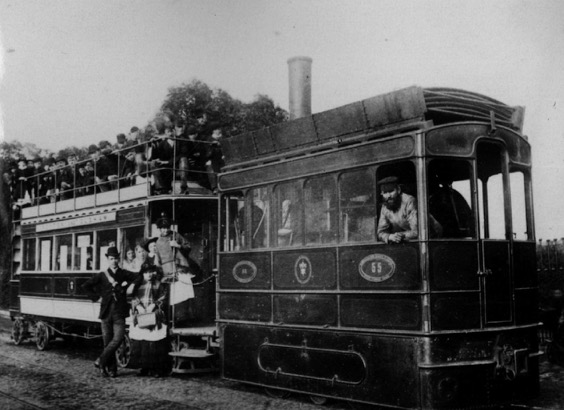
Standard-gauge Falcon Engine No 55 (of 1885) stands at what is probably Hathershaw (clearly a favoured photographic location) with a heavily loaded open-topped trailer. Although undated, the fact that the trailer is in excellent condition strongly suggests that the photograph was taken in 1885 or 1886, i.e., in MBR&OSTCo days. With thanks to the now defunct Bury Image Bank; Image b13724 — copyright Bury Archive Services.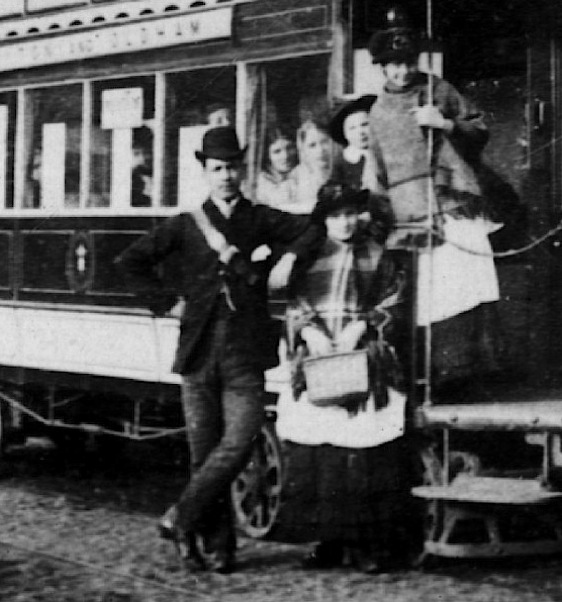
An enlargement of the above photograph, clearly showing that the conductor is wearing informal attire.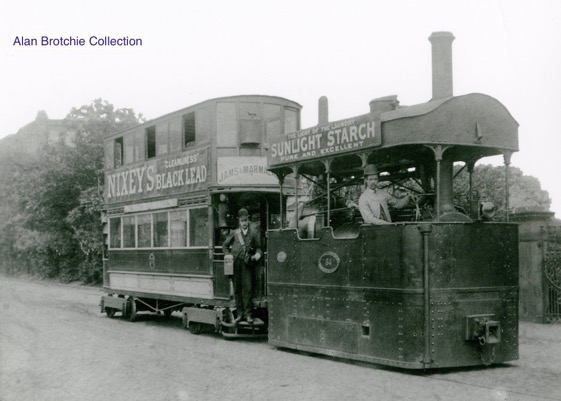
Standard gauge Manning Wardle No 54 (built in 1885), stands at what is probably Hathershaw, with what would appear to be No 73, a Lancaster-built trailer, delivered in 1886. Although undated, the fact that No 73 looks to be fairly new, suggests that it was taken in 1886 or 1887, i.e., in MBR&OSTCo days.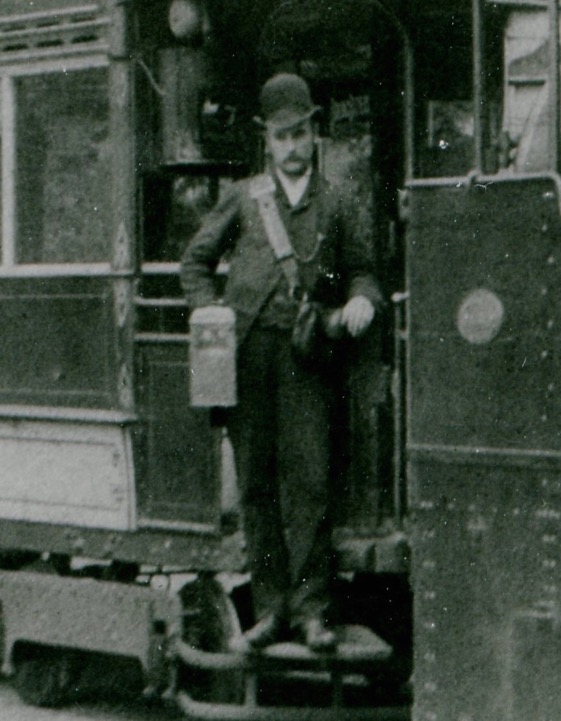
An enlargement of the above photograph showing the conductor; he is holding a Kayes Patent Fare Box and is wearing informal attire, including the distinctive tall bowler of the period with its upturned, curved brim. 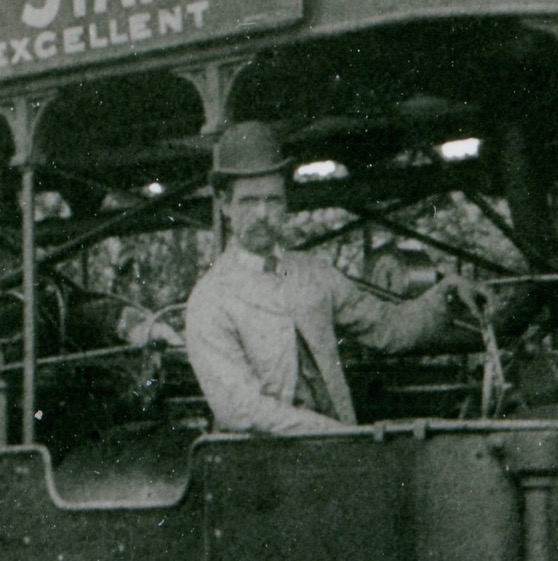
Another blow-up of the above photograph showing the driver; he is wearing a light-coloured cotton jacket, along with the characteristic bowler of the time.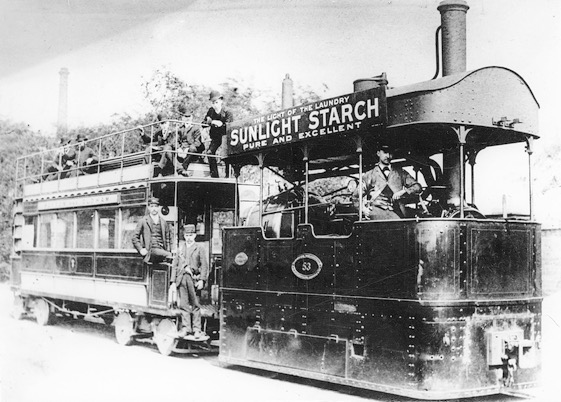
Another shot of a standard-gauge Manning Wardle, this time No 53 (of 1885), coupled to what would appear to be a fairly new Falcon-built trailer, at what is very probably Hathershaw — although undated, the excellent condition of the trailer and the fact that the conductor is wearing a kepi-style cap, strongly suggests that it was taken in the late 1880s, i.e., after the BR&OSTCo take-over. Photo courtesy of David Gladwin, with thanks to Trevor Preece.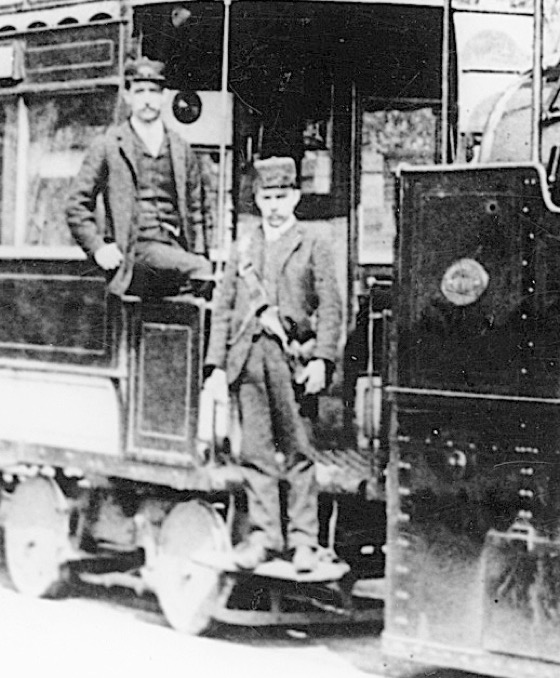
An enlargement of the above photograph showing the conductor, and another individual, both of whom are wearing kepi-style caps, suggesting that the photograph was taken after the BR&OSTCo had taken over. The conductor's cap looks to be plain, though it is difficult to tell, whilst the other individual, whose grade is unclear, would appear to have a cap badge.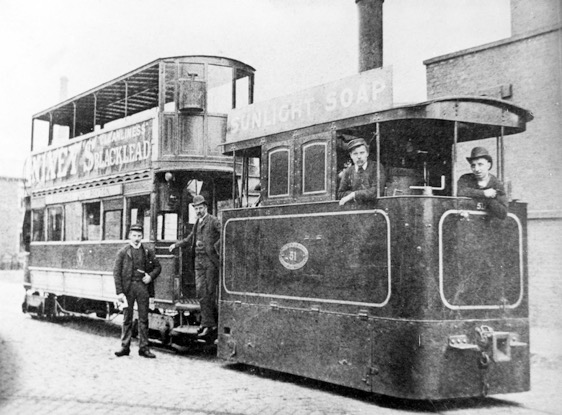
Narrow gauge Black Hawthorn Steam Tram No 51 (of 1884) captured in a depot yard — photo undated, but probably taken in the late 1880s, i.e., after the takeover of the BR&OSTCo, given that the conductor is wearing a kepi-style cap. Photo courtesy of David Gladwin, with thanks to Trevor Preece.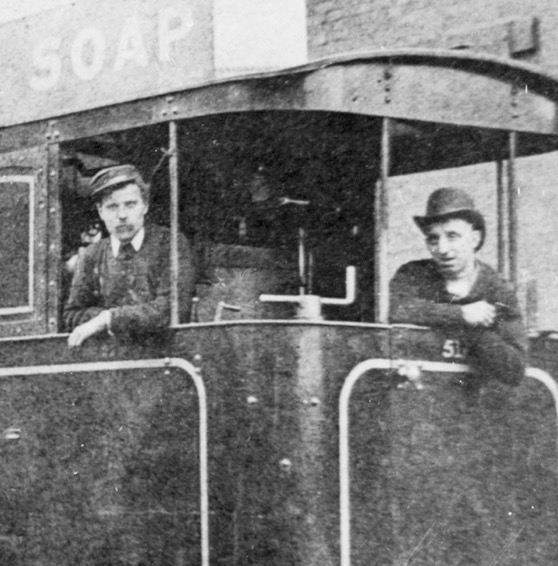
An enlargement of the above photograph showing the driver and stoker, the former in a soft-topped cap, and the latter in a bowler hat with upturned, curved brim typical of the 1880s.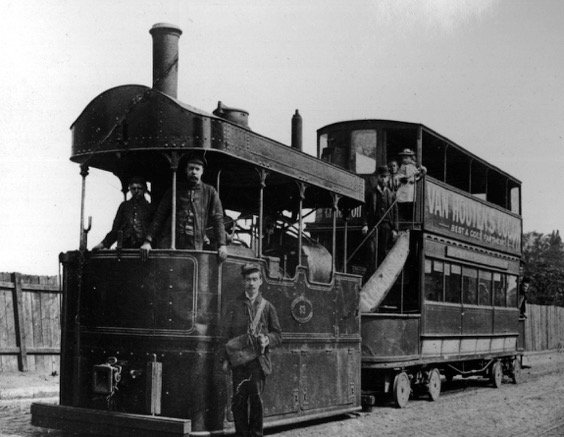
Manning Wardle No 53 at Hathershaw once again, this time in 1895, and looking a little more battered than the earlier photo, though still in relatively good condition. With thanks to the now defunct Bury Image Bank; Image b13719 — copyright Bury Archive Services.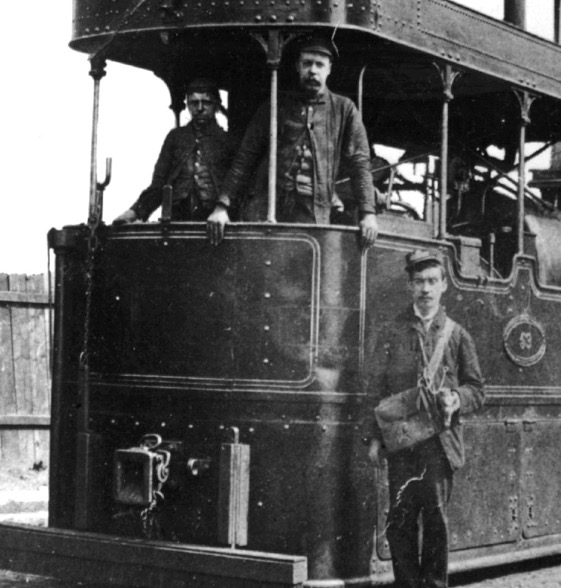
An enlargement of the above photograph showing the stoker, driver and conductor; the latter is wearing an informal jacket, along with a company-issued kepi-style cap and cap badge. The cap badge is oblong with a semi-circular protrusion on the top, a type that was very popular with American streetcar systems, and which was used by the North Metropolitan Tramways Company (see link) and the nearby Burnley & District Tramways (see link) in the UK.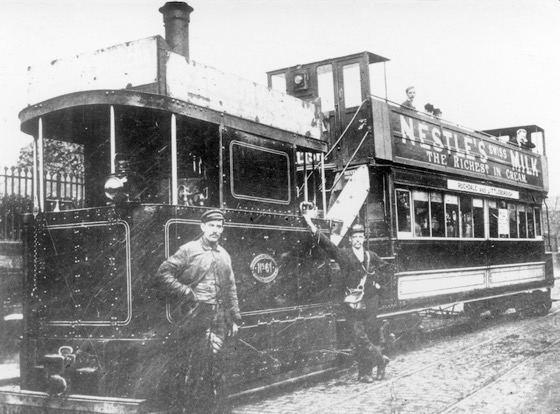
Narrow gauge 'Wilkinson' Engine No 61 (of 1885) captured on the Rochdale-Littleborough line in 1897. The rather bizarre looking trailer is probably No 22, a contraption built out of two original Starbuck trailers joined together, and supplemented by a bulkhead at each end to protect the passengers from smuts. Photo courtesy of David Gladwin, with thanks to Trevor Preece.
An enlargement of the above photograph showing the driver, in soft-topped cap, and the conductor in a kepi-style cap; the latter, which bears an oblong-shaped cap badge (with semi-circular protrusion on the top), has caught the light, strongly suggesting that it was metal rather than cloth.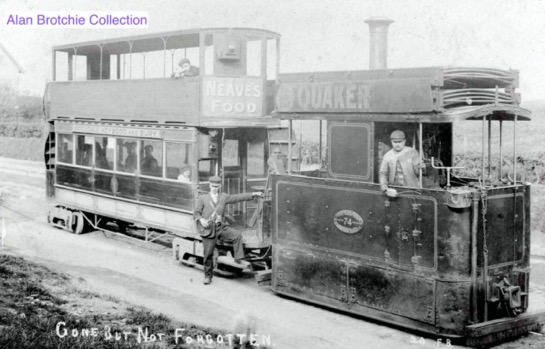
Narrow gauge 'Wilkinson Patent' Engine No 74 (built by Beyer Peacock in 1886), specially posed for the cameraman with a Falcon-built trailer in Bolton Rd, Marland (the boundary between Rochdale and Heywood — photo undated, but probably taken in the late 1890s. 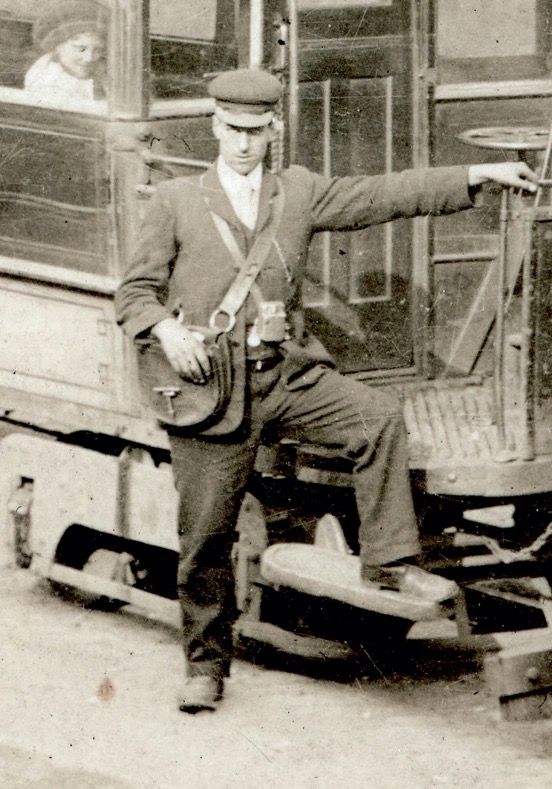
An enlargement of the above photograph showing the conductor, who is clearly wearing smart but informal attire.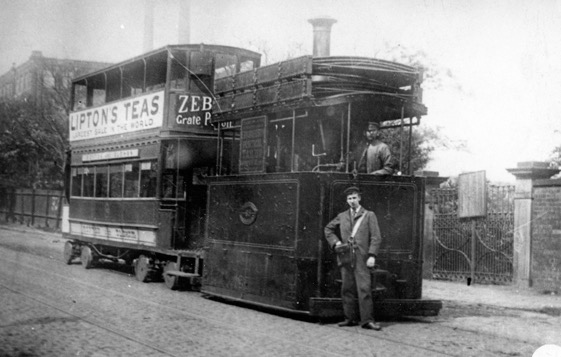
Tram Engine No 85 (a Beyer Peacock product of 1886) stands outside the Old Bell Mill in Hathershaw with a Falcon trailer in 1900. With thanks to John Holme of the Manchester Transport Museum Society.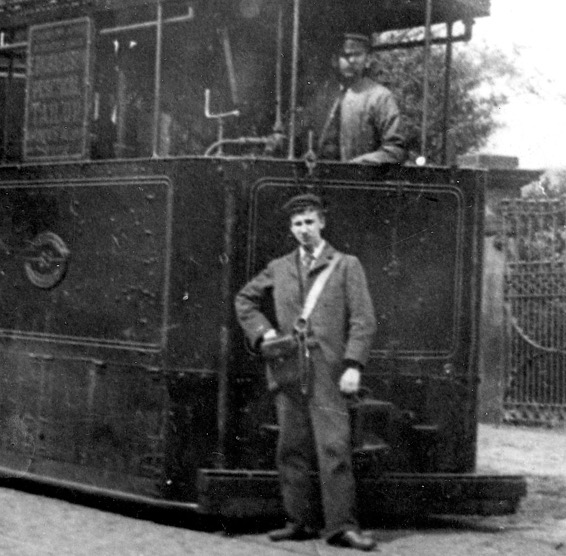
An enlargement of the above photograph showing the conductor, who is wearing informal attire and a flat cap, suggesting that the kepi-style caps had been dispensed with by the turn of the century.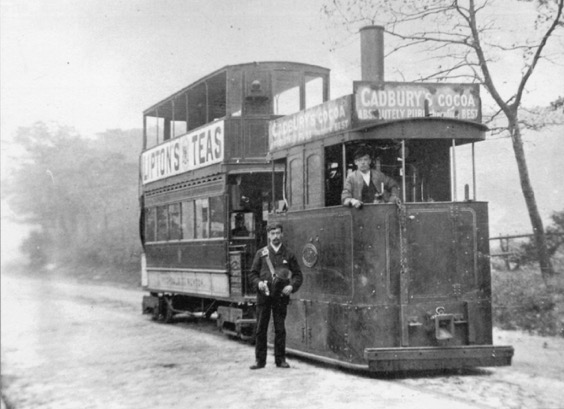
A narrow gauge 'Wilkinson' engine and trailer captured at what is probably Summit — photo undated, but more than likely taken around the turn of the century. Photo courtesy of the Tramways and Light Railway Society.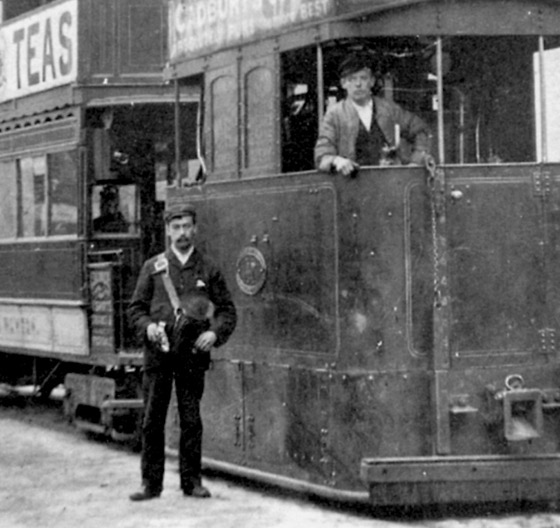
A blow-up of the above photo showing the driver and conductor, the latter once again in informal attire with a flat cap.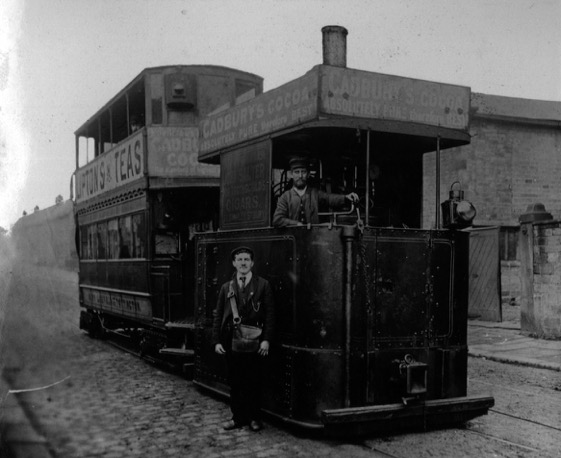
Narrow gauge Engine No 77 (a Wilkinson Patent locomotive built by Beyer Peacock & Co in 1886) posed for the camera with, if the trailer is to be believed, a Bury-Limefield-Tottington service. Although undated, the photograph was almost certainly taken very late in the tramway's life, probably in the early 1900s (this service was withdrawn in 1904). With thanks to the now defunct Bury Image Bank; Image b13698 — copyright Bury Archive Services.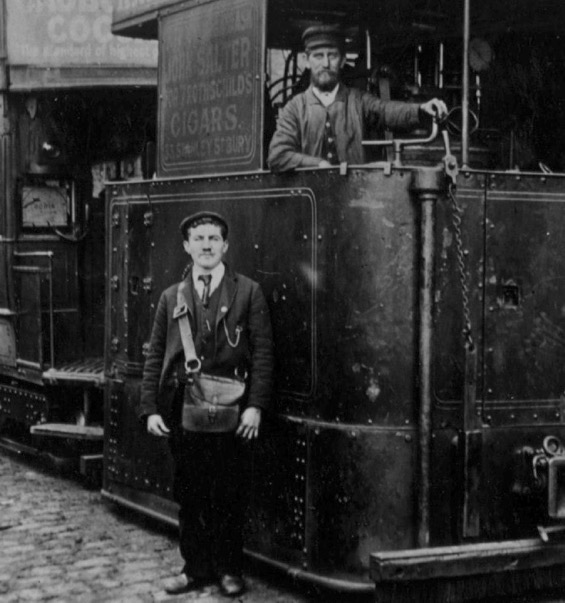
An enlargement of the above photograph showing the conductor and driver. By this time, the wearing of kepis had clearly been abandoned, with conductors simply wearing smart but informal attire, in this case, topped by a flat cap.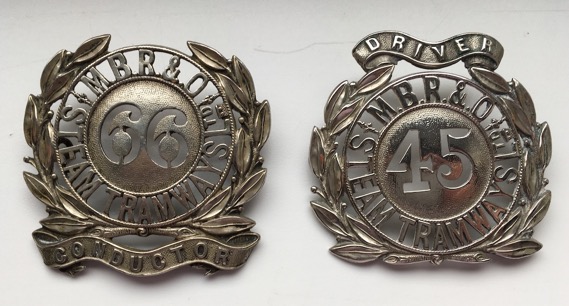
Manchester, Bury, Rochdale and Oldham Steam Tramways Ltd cap badges, No 66 CONDUCTOR and No 45 DRIVER — nickel. Both badges, and two others shown below are something of a mystery, as all surviving photos of the tramway — and there are dozens and dozens — clearly show that staff did not wear uniforms, except for the first ten years or so of the BR&OSTCo's tenure (circa 1888 to 1898), when conductors were issued with kepi-style caps; these however, carried a cap badge of a completely different shape. With thanks to Darren Lodge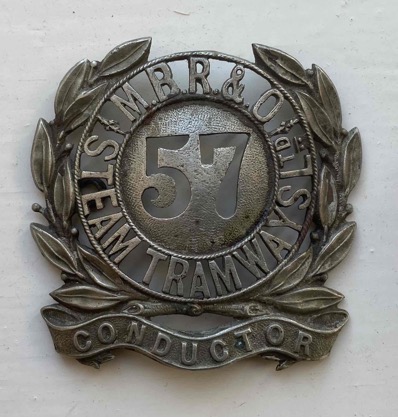
MBR&OSTCo conductor's cap badge No 57 — nickel. Author's Collection.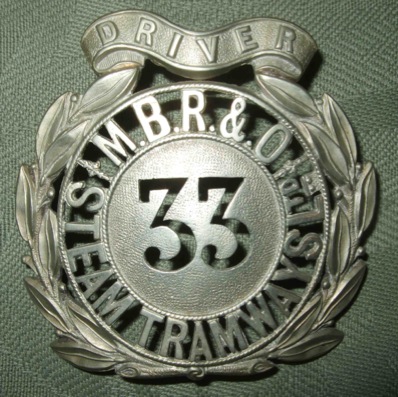
MBR&OSTCo driver's cap badge No 33 — nickel. Author's Collection.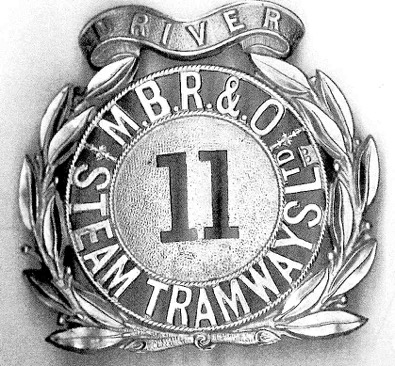
MBR&OSTCo driver's cap badge No 11 — nickel. With thanks to Nick Thurlow.